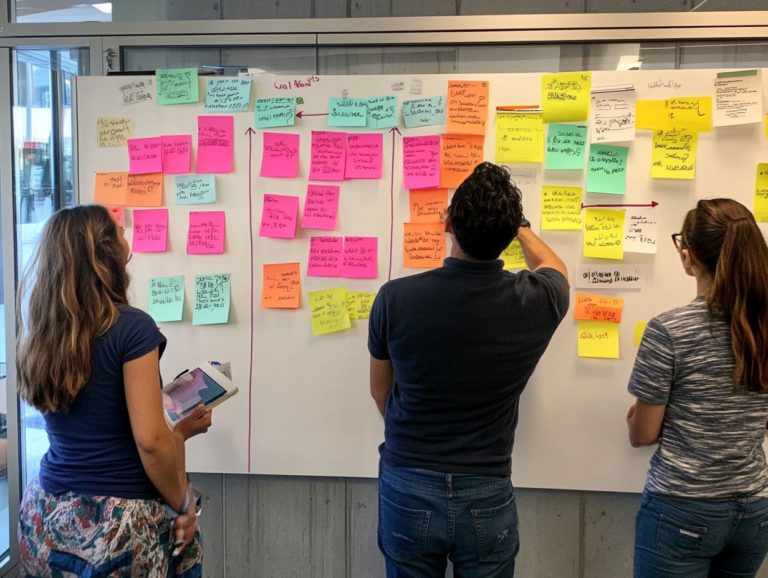How to Maintain Flexibility in Prioritization
In a fast-paced world where priorities can shift in an instant, mastering the art of prioritization becomes essential for you. Let s explore how effective prioritization can transform your productivity! This article illuminates its significance and the challenges you may face as you strive to remain flexible in a dynamic environment.
You ll encounter common obstacles that hinder adaptability, but fear not; we provide practical strategies to help you adjust your priorities with ease. By recognizing the benefits of maintaining flexibility, you can enhance your productivity and navigate change with unwavering confidence.
Dive in to uncover how to stay agile in your decision-making!
Contents
- Key Takeaways:
- What is Prioritization and Why It Matters?
- Challenges in Maintaining Flexibility
- Strategies for Maintaining Flexibility
- Benefits of Maintaining Flexibility in Prioritization
- Frequently Asked Questions
- What is the importance of maintaining flexibility in prioritization?
- How can I maintain flexibility in prioritization?
- What are some common challenges in maintaining flexibility in prioritization?
- How can I effectively manage conflicting priorities?
- What strategies can I use to stay flexible while keeping my priorities on track?
- How can I ensure that my flexible prioritization approach is effective?
Key Takeaways:

- Prioritization is the process of organizing tasks according to their importance and urgency.
- Maintaining flexibility in prioritization can be challenging due to common obstacles and limitations.
- Effective techniques for adapting priorities include regularly reviewing and reassessing tasks, delegating when necessary, and being open to change.
What is Prioritization and Why It Matters?
Understanding prioritization is essential for elevating your productivity and managing workloads across various areas, from personal tasks to team projects.
By establishing clear priorities, you can hone in on what s urgent and important. This makes certain that your daily and weekly activities align seamlessly with critical deadlines.
This approach not only optimizes resource allocation but also cultivates accountability and enhances your overall performance.
Definition and Importance
Prioritization is all about systematically arranging your tasks based on urgency and importance. It plays a crucial role in meeting deadlines and managing your workload effectively.
By using different methods to categorize your tasks, you can align your efforts more efficiently with your goals. For instance, the Eisenhower matrix helps you differentiate between what s urgent and what s truly important. It allows you to concentrate on high-impact activities while delegating or postponing less critical ones.
On the other hand, a Kanban board provides a visual representation of your tasks, simplifying an agile approach to workflow management. These methodologies boost your productivity and give you a clearer understanding of the various stages involved in project completion, ultimately leading to more effective goal-setting and adherence to deadlines.
Challenges in Maintaining Flexibility
Maintaining flexibility in prioritization presents a range of challenges that can significantly impact your task management and productivity. This is especially true in high-pressure environments, where deadlines are tight and project requirements are constantly changing. Learning about leveraging prioritization in fast-paced projects can be crucial for navigating these dynamics effectively.
You may encounter common obstacles like mental blocks or sudden shifts in workload, which can throw even the most carefully designed plans into disarray.
Common Obstacles and Limitations

Common obstacles in prioritization often include mental blocks, completion bias, and limitations in task assessment. These can hinder optimal task management and employee well-being.
These barriers can disrupt your workflow, leaving you and your team feeling overwhelmed and less engaged. Mental blocks might occur due to a lack of clarity or fear of making mistakes, often leading to procrastination and a dip in productivity.
Meanwhile, completion bias the tendency to gravitate toward easy or familiar tasks can prevent you from tackling more critical projects, ultimately stalling your overall progress. Limitations in task assessment can further cloud your judgment, hindering your ability to gauge which activities yield the best results.
To tackle these challenges, consider fostering an environment of open communication. Implement regular check-ins and encourage the use of task management tools that enhance clarity and boost employee engagement in strategic planning.
Start prioritizing today to improve your efficiency!
Strategies for Maintaining Flexibility
Implement effective strategies to maintain flexibility in your prioritization by using key techniques for setting priorities. This significantly elevates your productivity. Manage your tasks efficiently, and you create a smoother workflow.
Techniques like planning your tasks, the Pomodoro technique, and time chunking enable you to focus on one task at a time. This alleviates the overwhelm that often comes from juggling multiple responsibilities. Embrace these methods to take control of your time and enhance your overall efficiency.
Effective Techniques for Adapting Priorities
Utilizing effective techniques to adapt your priorities helps you navigate the complexities of project management and task execution, especially when you learn how to use prioritization to avoid burnout within a flexible framework.
By leveraging task decomposition, you can break large projects into manageable segments. This makes it easier to assign responsibilities and track progress. This structured approach supercharges collaboration and optimizes your workflow. It enables you and your team to focus on specific tasks that contribute to the overall objective.
Integrating project management software helps facilitate real-time communication and updates. This ensures everyone stays informed about changes and deadlines. These methods promote accountability and foster an environment where adaptability thrives. You and your team can respond swiftly to shifting demands and unforeseen challenges.
Benefits of Maintaining Flexibility in Prioritization
Keeping your priorities flexible opens the door to many exciting benefits, such as enhanced productivity and adaptability, both crucial for navigating the ever-evolving demands of personal and professional tasks. Understanding the role of prioritization in time management can further enhance these skills.
By skillfully organizing your tasks and fostering effective team communication, you unlock significant improvements in performance and achieve your goals with greater ease.
Improved Productivity and Adaptability

Improved productivity and adaptability stem directly from maintaining flexibility in task prioritization. This not only enables you to optimize your workforce but also enhances employee engagement, especially when you learn how to reassess priorities in changing situations.
When teams can swiftly shift their focus in response to changing project demands, you unlock a remarkable potential for creativity and efficiency. Consider a software development company that adopts agile methodologies. This approach allows them to reorganize tasks based on immediate client feedback while still meeting deadlines. Such a strategy fosters innovation and enables employees by prioritizing tasks that align with their strengths.
Incorporating tools like Kanban boards can significantly enhance your workflow management. This visual tool ensures everyone remains aligned on goals and adapts to unforeseen challenges, ultimately leading to impressive improvements in both team morale and project outcomes.
Final Thoughts and Recommendations
Maintaining a flexible approach to prioritization fosters accountability and enhances your ability to manage deadlines and execute personal tasks effectively, especially when following prioritization best practices in fast-paced environments.
This adaptive mindset enables you to respond to changing circumstances without losing sight of your objectives. It encourages you to periodically reassess your priorities. This ensures that urgent tasks receive the attention they deserve while also making room for your important long-term goals.
Embrace tools like digital planners or collaborative platforms to streamline this process. These tools provide clarity and transparency. Establish regular check-ins to evaluate your progress and reinforce accountability. This allows you to adjust your strategies as needed.
By prioritizing flexibility, you cultivate a balanced approach to task management. For insights on how to stay flexible in your planning, this ultimately leads to greater productivity and satisfaction.
Frequently Asked Questions
What is the importance of maintaining flexibility in prioritization?
Maintaining flexibility in prioritization allows individuals or organizations to adapt to changing circumstances, prioritize tasks effectively, and achieve goals efficiently.
How can I maintain flexibility in prioritization?

Regularly review and adjust your priorities based on new information. This helps you stay flexible.
What are some common challenges in maintaining flexibility in prioritization?
Conflicting priorities, limited resources, and unexpected disruptions are common challenges.
How can I effectively manage conflicting priorities?
Manage conflicting priorities by clearly communicating your needs. Negotiate deadlines and seek support from your team.
What strategies can I use to stay flexible while keeping my priorities on track?
Set aside time for unexpected tasks and learn to say no to non-essential tasks. Delegating can also help.
How can I ensure that my flexible prioritization approach is effective?
Regular reviews and adjustments are key. Keep stakeholders informed and track your progress towards goals.






